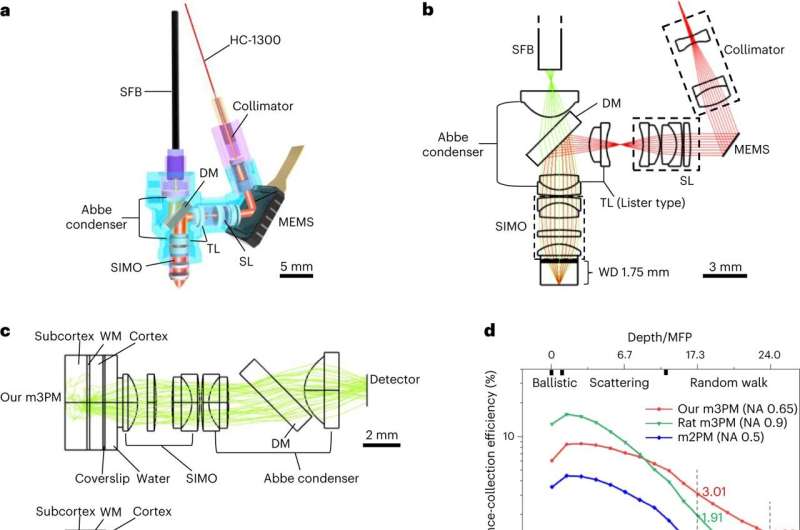This article has been reviewed according to Science X's editorial process and policies. Editors have highlighted the following attributes while ensuring the content's credibility:
fact-checked
peer-reviewed publication
trusted source
proofread
A three-photon microscope for capturing deep-brain images

A research team at China's Peking University has made a new breakthrough in multiphoton microscopy by developing a miniature three-photon microscope that has successfully captured deep-brain images of freely moving mice.
The microscope, weighing only 2.17 grams, achieved stable imaging of the brain cortex and hippocampal neurons of freely moving mice, an innovation that shows promise as a method for revealing the mysteries of the human brain.
The study was published in Nature Methods.
What is the research about?
The human brain contains billions of neurons and trillions of synapses, and mapping its connectivity and functional dynamics has been one focus of global brain research, with wearable microscopic imaging devices applicable to small animals as one of the research tools.
A team led by Cheng Heping, director of the National Biomedical Imaging Center at Peking University, has been working on developing such devices for years.
The team developed its first miniature two-photon microscope with a weight of 2.2 grams in 2017 and obtained dynamic images of neuronal and synaptic activities in the cerebral cortex of mice during free movement.
After four years of development, an upgraded two-photon microscope enlarged the imaging field by 7.8 times and could capture three-dimensional images of the functional signals of cerebral cortex neurons, said Cheng, also an academician of the Chinese Academy of Sciences.
How is the new device more advanced?
The new three-photon microscope developed by the team led by Cheng and Wang Aimin, a researcher at Peking University, features a larger imaging depth compared with the previous miniature multiphoton microscopes.
It penetrated the entire cortex and callosum of freely moving mice and captured images of calcium activity of a hippocampal region at a depth up to 1.2 millimeters, which had been a great challenge for neuroscientists across the globe.
Calcium activity is an indicator reflecting the cellular activity of neurons and can be monitored when combining with fluorescent molecules, a calcium indicator. However, the light scattering in brain tissue, especially the callosum under the cortex, results in a short penetration distance of fluorescence, which limits the imaging depth.
The hippocampus lies beneath the cortex and callosum. Previous miniature multiphoton microscopes across the world had failed to capture its non-invasive imaging, said Zhao Chunzhu, a team member at the College of Future Technology under Peking University.
The three-photon microscope developed by the team successfully achieved the imaging in the deep brains of freely moving mice thanks to an innovative optical configuration, which maximized the collection efficiency of scattering fluorescence.
The microscope features the additional advantage of low phototoxicity, causing no obvious photobleaching or photodamage during the long-time observation of neuronal activities, according to the study.
More information: Chunzhu Zhao et al, Miniature three-photon microscopy maximized for scattered fluorescence collection, Nature Methods (2023). DOI: 10.1038/s41592-023-01777-3





















